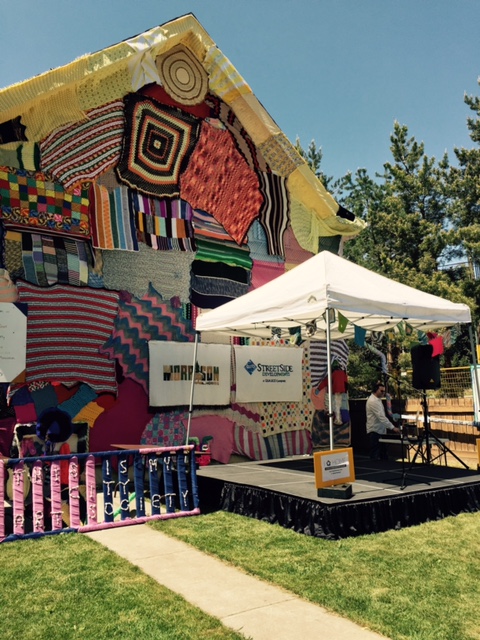Cameron Bailey is the Calgary Homeless Foundation’s (CHF’s) new Chair of the Board and has served on the Calgary Homeless Foundation’s board since 2010. Cam and his wife Gelaine spent 15 years living overseas and have volunteered numerous times in rural communities in Africa. Some of their most memorable trips to Africa include time spent in Ethiopia, Tanzania, Rwanda, Kenya and South Africa. Cam has a B. Commerce degree from UBC and an MBA from the Wharton School at the University of Pennsylvania. He is active with other boards including the Alberta Energy Regulator, the UBC Sauder Business School and Westside King’s Church where he serves as past Chair of the Board of Trustees. Cam also served on the board of the Telus Spark Calgary Science Center from 2010-2015.
Recently, Cam took some time out from his busy volunteer schedule to share his thoughts on ending homelessness, volunteering and his new role as Chair of CHF’s Board of Directors.
Q: What inspired you to begin serving on the CHF board in 2010?
A: When we moved back to Calgary in 2009 after being away from the city for 15 years living overseas, I wanted to re-engage in the community. I spent my first few months back in Calgary talking to community leaders about what the big leverage points were, and what initiatives were underway that could potentially have the most impact on our city. I kept hearing about the Calgary Homeless Foundation and the 10 Year Plan to End Homelessness. It became pretty evident that this was one of Calgary’s big, bold, exciting, initiatives and, at the time, quite unique in Canada. I soon joined the board and got immersed in the mission to end homelessness.
Q: You’re retired now and this position is a big commitment. What drives you to volunteer like you do?
A: After several years on the board, I’m even more of a believer in the mission and in the opportunity we have through Calgary’s Plan to End Homelessness. After serving for the last two years as Vice Chair, and learning a lot from Alan Norris, it seemed like a logical next step to move into the Chair role when Alan announced his intentions to step down and focus his efforts chairing the RESOLVE campaign. I knew that this was an important opportunity to continue to make a difference.
Q: What do you see as the role of the Chair of the Board?
A: The biggest part of the role is to work with the board to support Diana [Krecsy] as President & CEO, and, in turn, support the team at CHF to deliver on the objectives of the Plan. I believe it’s also the responsibility of the Chair, and of the board members more broadly, to keep the focus on delivering against the Plan, to make sure that we’re out in the community, talking to people, supporting this important initiative. We can’t forget that through the excellent work of all the agencies in Calgary’s homelessness serving sector, people’s lives are changed, one at a time. And the clock is ticking. We all feel the sense of urgency to get people off the street and into supportive housing, with the services they need to get back on their feet.
Q: What are your top three priorities as Chair?
A: Our first priority is to support Diana and the management team establish the new Community Council (CC). With the creation of the CC, CHF can refocus on what our original role was intended to be – to serve as the orchestrator of the mission to end homelessness and to be the backbone entity that tracks sector progress towards this goal across the overall system of care. Our second priority is to focus on encouraging more connectivity and collaboration within the homeless serving sector. Because homelessness is a large and complex problem to solve, as a community we will be much more impactful working as a collective whole, sharing resources and capabilities rather than working independently of each other, often without the scale necessary for significant impact, and in some cases even duplicating services and “competing” for clients, staff and funding. And our third priority is to bring us as a Board closer to understanding and appreciating the front line experience and successes that agencies are having in Calgary. Beginning in September, we’re looking at having our board meetings on-site at different agency locations. By being “on-site” we hope to be able to tour the facilities, hear directly from a staff or a client about the work they are doing and invite the agency CEO and board chair to tell us about their strategic direction.
Q: Where do you see CHF in a year to three years?
A: In these next three years, our biggest goal is just driving full steam ahead to achieve the goals of the Plan to End Homelessness. It’s an all hands on deck approach to deliver on the commitments of the Plan. The key to success will be through community ownership of the Plan, hence the priority on getting the Community Council established. Beyond that, as a board we have begun the process of thinking through the role of CHF post 2018. We don’t have those answers yet.
Q: What are some impressions that you’ve taken away from your time in Africa? Are there any parallels you’ve noticed from your volunteer work there to your work here in Calgary?
A: My wife and I have spent a lot of time in Africa, in remote places, getting exposure to people who are the most in need and the most at risk. We’ve had the chance to sit in classrooms in rural schools, and to see the joy on children’s faces as they describe what their dreams are. In many respects, you hear the same career aspirations that you would sitting in a Calgary elementary school classroom – the kids in rural African communities want to grow up to be engineers, doctors, teachers, scientists and nurses. But because of the birth lottery, the kids in Africa don’t have the clear pathways to these careers like our own children do here in Canada. Bright, ambitious young kids in these rural African communities may never have the chance to get through grade school, let alone attend a college or university. It’s wasted talent, and an incredible amount of untapped human potential. Progress in being made, but the pace is frustratingly slow. Again, in trying to solve a large and complex problem, scale is important. Large, well run organisations like World Vision do great work, and have significant impact, by working at the community level, empowering a whole village to move out of poverty and become self sustaining. Here in Calgary, in this city of immense wealth, we take pride in working together as community to look after our own, to ensure nobody is left behind. And, in parallel, as a community, we can extend a helping hand beyond our city borders to help those in need elsewhere, to make the world a better and safer place for those less fortunate. The Plan to End Homelessness is one important aspect of our broader obligations.



